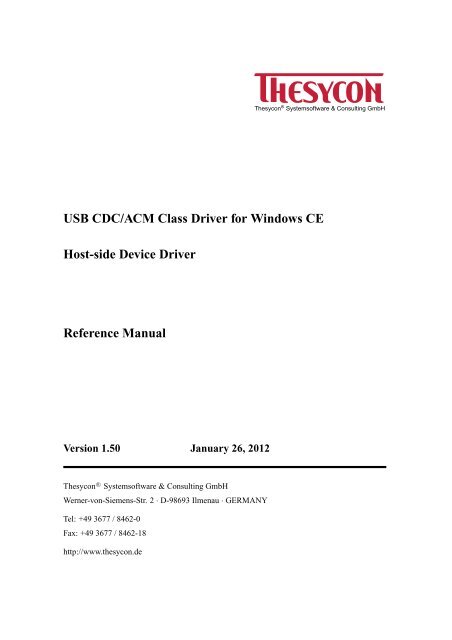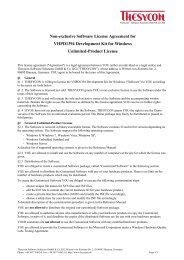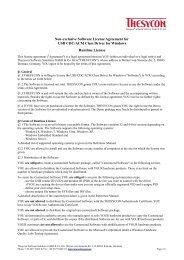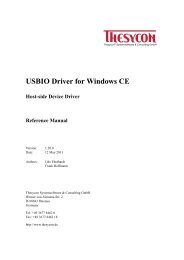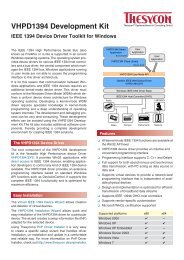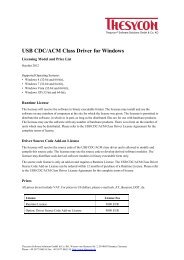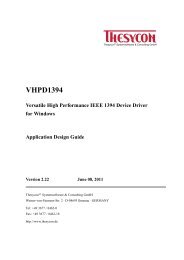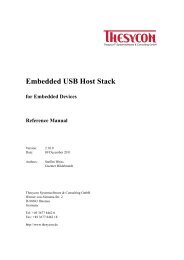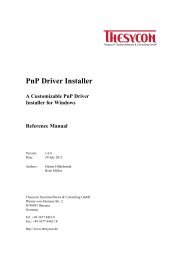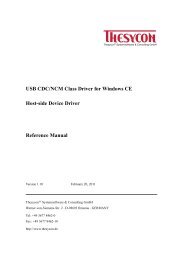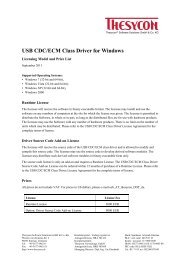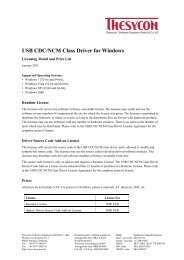USB CDC/ACM Class Driver for Windows CE - Thesycon ...
USB CDC/ACM Class Driver for Windows CE - Thesycon ...
USB CDC/ACM Class Driver for Windows CE - Thesycon ...
You also want an ePaper? Increase the reach of your titles
YUMPU automatically turns print PDFs into web optimized ePapers that Google loves.
® <strong>Thesycon</strong> Systemsoftware&ConsultingGmbH<br />
<strong>USB</strong> <strong>CDC</strong>/<strong>ACM</strong> <strong>Class</strong> <strong>Driver</strong> <strong>for</strong> <strong>Windows</strong> <strong>CE</strong><br />
Host-side Device <strong>Driver</strong><br />
Reference Manual<br />
Version 1.50 January 26, 2012<br />
<strong>Thesycon</strong> R○ Systemsoftware & Consulting GmbH<br />
Werner-von-Siemens-Str. 2 · D-98693 Ilmenau · GERMANY<br />
Tel: +49 3677 / 8462-0<br />
Fax: +49 3677 / 8462-18<br />
http://www.thesycon.de
Copyright (c) 2007-2012 by <strong>Thesycon</strong> Systemsoftware & Consulting GmbH<br />
All Rights Reserved<br />
Disclaimer<br />
In<strong>for</strong>mation in this document is subject to change without notice. No part of this manual may be<br />
reproduced, stored in a retrieval system, or transmitted in any <strong>for</strong>m or by any means electronic or<br />
mechanical, including photocopying and recording <strong>for</strong> any purpose other than the purchaser’s personal<br />
use, without prior written permission from <strong>Thesycon</strong> Systemsoftware & Consulting GmbH.<br />
The software described in this document is furnished under the software license agreement distributed<br />
with the product. The software may be used or copied only in accordance with the terms<br />
of the license.<br />
Trademarks<br />
The following trade names are referenced throughout this manual:<br />
Microsoft, <strong>Windows</strong>, Win32, <strong>Windows</strong> NT, <strong>Windows</strong> XP, <strong>Windows</strong> Vista, <strong>Windows</strong> 7, Visual Studio,<br />
<strong>Windows</strong> <strong>CE</strong>, <strong>Windows</strong> Embedded and <strong>Windows</strong> Embedded Compact are either trademarks<br />
or registered trademarks of Microsoft Corporation.<br />
Other brand and product names are trademarks or registered trademarks of their respective holders.
Contents<br />
Contents<br />
Table of Contents 7<br />
References 9<br />
1 Introduction 11<br />
2 Overview 12<br />
2.1 Architecture . . . . . . . . . . . . . . . . . . . . . . . . . . . . . . . . . . . . . 12<br />
2.2 Features . . . . . . . . . . . . . . . . . . . . . . . . . . . . . . . . . . . . . . . 13<br />
2.3 Supported Plat<strong>for</strong>ms . . . . . . . . . . . . . . . . . . . . . . . . . . . . . . . . 14<br />
2.3.1 <strong>Windows</strong> <strong>CE</strong> Versions . . . . . . . . . . . . . . . . . . . . . . . . . . . 14<br />
2.3.2 <strong>Windows</strong> <strong>CE</strong> SDKs and CPU Architectures . . . . . . . . . . . . . . . . 14<br />
2.3.3 <strong>Windows</strong> <strong>CE</strong> 6 and <strong>Windows</strong> Embedded Compact 7 . . . . . . . . . . . 15<br />
2.4 Support <strong>for</strong> <strong>USB</strong> Host Controllers . . . . . . . . . . . . . . . . . . . . . . . . . 15<br />
3 <strong>USB</strong> Device Requirements 16<br />
3.1 <strong>USB</strong> Descriptors . . . . . . . . . . . . . . . . . . . . . . . . . . . . . . . . . . 16<br />
3.1.1 <strong>USB</strong> <strong>CDC</strong>/<strong>ACM</strong> <strong>Class</strong> Compliant Descriptors . . . . . . . . . . . . . . 16<br />
3.1.2 Non-class Compliant Descriptors . . . . . . . . . . . . . . . . . . . . . 16<br />
3.1.3 Interface Association Descriptor (IAD) . . . . . . . . . . . . . . . . . . 16<br />
3.1.4 Union Interface Functional Descriptor . . . . . . . . . . . . . . . . . . . 17<br />
3.1.5 Composite Devices . . . . . . . . . . . . . . . . . . . . . . . . . . . . . 17<br />
3.2 <strong>USB</strong> <strong>Class</strong> Requests . . . . . . . . . . . . . . . . . . . . . . . . . . . . . . . . 17<br />
3.3 <strong>USB</strong> Data Pipes . . . . . . . . . . . . . . . . . . . . . . . . . . . . . . . . . . . 17<br />
3.3.1 Bulk IN Pipe Behavior . . . . . . . . . . . . . . . . . . . . . . . . . . . 17<br />
3.3.2 Bulk IN Pipe Configuration . . . . . . . . . . . . . . . . . . . . . . . . 18<br />
3.3.3 Bulk OUT Pipe Behavior . . . . . . . . . . . . . . . . . . . . . . . . . . 19<br />
4 <strong>Driver</strong> Customization 20<br />
4.1 Customization Steps . . . . . . . . . . . . . . . . . . . . . . . . . . . . . . . . 21<br />
4.1.1 Configuration of Names . . . . . . . . . . . . . . . . . . . . . . . . . . 21<br />
4.1.2 Configuration of Software Interface Identifiers . . . . . . . . . . . . . . 21<br />
5 <strong>Driver</strong> Installation and Uninstallation 23<br />
5.1 CAB File Installation . . . . . . . . . . . . . . . . . . . . . . . . . . . . . . . . 23<br />
5.1.1 Installing <strong>USB</strong> <strong>CDC</strong>/<strong>ACM</strong> . . . . . . . . . . . . . . . . . . . . . . . . . 23<br />
<strong>USB</strong> <strong>CDC</strong>/<strong>ACM</strong> <strong>Class</strong> <strong>Driver</strong> <strong>for</strong> <strong>Windows</strong> <strong>CE</strong> 5
Contents<br />
5.1.2 Uninstalling <strong>USB</strong> <strong>CDC</strong>/<strong>ACM</strong> . . . . . . . . . . . . . . . . . . . . . . . 23<br />
5.2 Plat<strong>for</strong>m Integration . . . . . . . . . . . . . . . . . . . . . . . . . . . . . . . . . 23<br />
5.3 Manual Installation . . . . . . . . . . . . . . . . . . . . . . . . . . . . . . . . . 23<br />
5.4 usb_ce_install . . . . . . . . . . . . . . . . . . . . . . . . . . . . . . . . . . . . 23<br />
5.5 Registry Samples . . . . . . . . . . . . . . . . . . . . . . . . . . . . . . . . . . 24<br />
6 <strong>Driver</strong> Configuration 26<br />
6.1 CAB File Sample Projects . . . . . . . . . . . . . . . . . . . . . . . . . . . . . 26<br />
6.2 <strong>USB</strong> Bus <strong>Driver</strong> Loading Mechanism . . . . . . . . . . . . . . . . . . . . . . . 26<br />
6.2.1 Registration in Case of <strong>Class</strong> Compliant Descriptors . . . . . . . . . . . 27<br />
6.2.2 Registration in Case of Non-class Compliant Descriptors . . . . . . . . . 27<br />
6.3 <strong>Driver</strong>-defined Registry Locations . . . . . . . . . . . . . . . . . . . . . . . . . 27<br />
6.3.1 Config Key . . . . . . . . . . . . . . . . . . . . . . . . . . . . . . . . . 27<br />
6.3.2 Template Key . . . . . . . . . . . . . . . . . . . . . . . . . . . . . . . . 29<br />
6.4 COM Port Number Assignment . . . . . . . . . . . . . . . . . . . . . . . . . . 29<br />
6.5 Modem Configuration . . . . . . . . . . . . . . . . . . . . . . . . . . . . . . . . 29<br />
6.6 <strong>Driver</strong> Configuration Parameters . . . . . . . . . . . . . . . . . . . . . . . . . . 30<br />
6.6.1 BufferCountIn . . . . . . . . . . . . . . . . . . . . . . . . . . . . . . . 30<br />
6.6.2 BufferCountOut . . . . . . . . . . . . . . . . . . . . . . . . . . . . . . 30<br />
6.6.3 BufferSizeFactorIn . . . . . . . . . . . . . . . . . . . . . . . . . . . . . 31<br />
6.6.4 BufferSizeFactorOut . . . . . . . . . . . . . . . . . . . . . . . . . . . . 31<br />
6.6.5 NumberOfControlInBuffers . . . . . . . . . . . . . . . . . . . . . . . . 31<br />
6.6.6 FifoSizeIn . . . . . . . . . . . . . . . . . . . . . . . . . . . . . . . . . . 31<br />
6.6.7 FifoSizeOut . . . . . . . . . . . . . . . . . . . . . . . . . . . . . . . . . 31<br />
6.6.8 SendShortPacketsOut . . . . . . . . . . . . . . . . . . . . . . . . . . . . 31<br />
6.6.9 SupportSetControlLineState . . . . . . . . . . . . . . . . . . . . . . . . 32<br />
6.6.10 SupportSetLineCoding . . . . . . . . . . . . . . . . . . . . . . . . . . . 32<br />
6.6.11 SupportGetLineCoding . . . . . . . . . . . . . . . . . . . . . . . . . . . 32<br />
6.6.12 SupportSendBreak . . . . . . . . . . . . . . . . . . . . . . . . . . . . . 32<br />
6.6.13 PowerManagementLevel . . . . . . . . . . . . . . . . . . . . . . . . . . 32<br />
6.7 Device Specific Parameters . . . . . . . . . . . . . . . . . . . . . . . . . . . . . 33<br />
6.7.1 IdleTimerInterval . . . . . . . . . . . . . . . . . . . . . . . . . . . . . . 33<br />
6.7.2 SetRemoteWakeUp . . . . . . . . . . . . . . . . . . . . . . . . . . . . . 33<br />
6.7.3 RequestD3viaPM . . . . . . . . . . . . . . . . . . . . . . . . . . . . . . 33<br />
6.8 Power Management . . . . . . . . . . . . . . . . . . . . . . . . . . . . . . . . . 33<br />
6 <strong>USB</strong> <strong>CDC</strong>/<strong>ACM</strong> <strong>Class</strong> <strong>Driver</strong> <strong>for</strong> <strong>Windows</strong> <strong>CE</strong>
Contents<br />
6.9 COM Port Enumeration . . . . . . . . . . . . . . . . . . . . . . . . . . . . . . . 34<br />
7 Source Code Package 35<br />
7.1 Build Instructions . . . . . . . . . . . . . . . . . . . . . . . . . . . . . . . . . . 35<br />
8 Debugging Support 36<br />
8.1 Enable Debug Traces . . . . . . . . . . . . . . . . . . . . . . . . . . . . . . . . 36<br />
<strong>USB</strong> <strong>CDC</strong>/<strong>ACM</strong> <strong>Class</strong> <strong>Driver</strong> <strong>for</strong> <strong>Windows</strong> <strong>CE</strong> 7
References<br />
[1] Universal Serial Bus Specification 1.1,<br />
http://www.usb.org<br />
[2] Universal Serial Bus Specification 2.0,<br />
http://www.usb.org<br />
[3] <strong>USB</strong> Communications Device <strong>Class</strong>,<br />
http://www.usb.org/developers/devclass_docs/<br />
[4] Microsoft Developer Network (MSDN) Library,<br />
http://msdn.microsoft.com/library/<br />
[5] <strong>Windows</strong> Plat<strong>for</strong>m SDK,<br />
http://msdn.microsoft.com/library/<br />
[6] Plat<strong>for</strong>m Builder <strong>for</strong> <strong>Windows</strong> <strong>CE</strong> 5.0 Help,<br />
http://msdn.microsoft.com/library/<br />
References<br />
<strong>USB</strong> <strong>CDC</strong>/<strong>ACM</strong> <strong>Class</strong> <strong>Driver</strong> <strong>for</strong> <strong>Windows</strong> <strong>CE</strong> 9
1 Introduction<br />
1 Introduction<br />
The <strong>CDC</strong>/<strong>ACM</strong> class driver <strong>for</strong> <strong>Windows</strong> <strong>CE</strong> and <strong>Windows</strong> Mobile is a driver <strong>for</strong> <strong>USB</strong> devices<br />
which are compliant to the Communication Device <strong>Class</strong> (<strong>CDC</strong>), sub class Abstract Control Model<br />
(<strong>ACM</strong>) defined by the <strong>USB</strong> Implementers Forum. For each <strong>CDC</strong>/<strong>ACM</strong> device instance the driver<br />
exposes a serial COM port and emulates the behavior of legacy (physical) COM ports. That means<br />
the driver supports the standard Win32 API calls typically used <strong>for</strong> serial communication, such as<br />
CreateFile, WriteFile, ReadFile, SetCommState, SetCommMask, WaitCommEvent, etc.<br />
The driver supports devices which are fully compliant to the <strong>CDC</strong>/<strong>ACM</strong> specification and devices<br />
which implement a subset of this specification only. See section 3 on page 16 <strong>for</strong> details about<br />
the supported protocols. The driver can be used with both <strong>USB</strong> 1.1 and <strong>USB</strong> 2.0 devices which<br />
operate at full speed or high speed.<br />
This document describes the architecture and the features of the <strong>CDC</strong>/<strong>ACM</strong> class driver. Furthermore,<br />
it includes instructions <strong>for</strong> installing and using the driver.<br />
The reader of this document is assumed to be familiar with the specification of the Universal<br />
Serial Bus (<strong>USB</strong>) Version 1.1 and 2.0, the <strong>CDC</strong>/<strong>ACM</strong> specification and with common aspects of<br />
Win32-based application programming.<br />
<strong>USB</strong> <strong>CDC</strong>/<strong>ACM</strong> <strong>Class</strong> <strong>Driver</strong> <strong>for</strong> <strong>Windows</strong> <strong>CE</strong> 11
2 Overview<br />
2 Overview<br />
2.1 Architecture<br />
Figure 1 shows the <strong>USB</strong> driver stack of the <strong>Windows</strong> <strong>CE</strong> operating system with the <strong>USB</strong> <strong>CDC</strong>/<strong>ACM</strong><br />
class driver.<br />
The following modules are shown in Figure 1:<br />
Figure 1: <strong>USB</strong> <strong>Driver</strong> Stack<br />
• <strong>USB</strong> Host Controller is the hardware component that controls the Universal Serial Bus.<br />
It also contains the <strong>USB</strong> Root Hub. There are two standard implementations of the host<br />
controller that support <strong>USB</strong> full speed: Open Host Controller (OHC) and Universal Host<br />
Controller (UHC). There is one standard implementation of the host controller that supports<br />
<strong>USB</strong> high speed: Enhanced Host Controller (EHC). Except these standard implementations<br />
third party <strong>USB</strong> Host Controller driver are available.<br />
• UHCI.DLL, OHCI.DLL, OHCI2.DLL and EHCI.DLL are host controller drivers provided<br />
by Microsoft.<br />
• <strong>USB</strong>D.DLL is the <strong>USB</strong> bus driver that controls and manages all devices connected to the<br />
<strong>USB</strong>. It is provided by Microsoft as part of the operating system.<br />
12 <strong>USB</strong> <strong>CDC</strong>/<strong>ACM</strong> <strong>Class</strong> <strong>Driver</strong> <strong>for</strong> <strong>Windows</strong> <strong>CE</strong>
2 Overview<br />
• <strong>USB</strong>HUB.DLL is the <strong>USB</strong> hub driver provided by Microsoft. It is responsible <strong>for</strong> managing<br />
and controlling <strong>USB</strong> Hubs.<br />
• <strong>USB</strong><strong>CDC</strong>.DLL is the <strong>USB</strong> <strong>CDC</strong>/<strong>ACM</strong> class driver. It emulates a serial COM port and<br />
supports the standard Win32 API class <strong>for</strong> COM ports.<br />
The software interface that is provided by the operating system <strong>for</strong> use by <strong>USB</strong> device drivers<br />
is called <strong>USB</strong> Host <strong>Driver</strong> Interface (<strong>USB</strong>DI). It is an function pointer interface exported by the<br />
<strong>USB</strong>D.<br />
2.2 Features<br />
The features provided by the <strong>USB</strong> <strong>CDC</strong>/<strong>ACM</strong> class driver are summarized below.<br />
• <strong>USB</strong> Support. The <strong>CDC</strong>/<strong>ACM</strong> class driver supports <strong>USB</strong> 2.0 and <strong>USB</strong> 1.1 at full and high<br />
speed.<br />
• COM Port. The <strong>CDC</strong>/<strong>ACM</strong> class driver provides a virtual serial COM port. The provided<br />
virtual COM port is compatible with the Win32 serial port API. The virtual COM port can<br />
be used by standard <strong>Windows</strong> programs. The COM port name gets assigned automatically.<br />
• <strong>USB</strong> Protocols. Different <strong>USB</strong> protocols are supported. It supports devices that are compliant<br />
with the <strong>CDC</strong>/<strong>ACM</strong> class specification and proprietary variants of the <strong>CDC</strong>/<strong>ACM</strong><br />
protocol with a simplified or incomplete implementation of that protocol.<br />
• Asynchronous Data Transfer. Fully supports asynchronous (overlapped) data transfer operations.<br />
• Plug&Play. The <strong>CDC</strong>/<strong>ACM</strong> class driver fully supports plug and play. It supports add/remove<br />
notifications. An additional GUID based interface enables the usage of PnP events. So a<br />
Plug&Play compliant port enumeration and identification method that is not based on COM<br />
port names is provided.<br />
• Power Management. The <strong>CDC</strong>/<strong>ACM</strong> class driver supports the <strong>Windows</strong> <strong>CE</strong> power management<br />
model. It also supports <strong>USB</strong> suspend.<br />
• Multiple <strong>USB</strong> Interfaces. The <strong>CDC</strong>/<strong>ACM</strong> class driver can be used with devices that implement<br />
multiple <strong>USB</strong> interfaces. A separate serial port instance will be created <strong>for</strong> each<br />
<strong>CDC</strong>/<strong>ACM</strong> instance.<br />
• Multiple <strong>USB</strong> Devices. Multiple <strong>USB</strong> devices can be controlled by the driver at the same<br />
time.<br />
• Composite devices. The <strong>CDC</strong>/<strong>ACM</strong> class driver supports composite devices which combine<br />
one ore more <strong>CDC</strong>/<strong>ACM</strong> interfaces with other functionality (e.g. Mass Storage class).<br />
• Modem devices. The <strong>CDC</strong>/<strong>ACM</strong> class driver supports modem device using unimodem<br />
driver. For using the serial port as a modem additional modem device specific registry<br />
settings are needed.<br />
<strong>USB</strong> <strong>CDC</strong>/<strong>ACM</strong> <strong>Class</strong> <strong>Driver</strong> <strong>for</strong> <strong>Windows</strong> <strong>CE</strong> 13
2 Overview<br />
2.3 Supported Plat<strong>for</strong>ms<br />
2.3.1 <strong>Windows</strong> <strong>CE</strong> Versions<br />
The <strong>CDC</strong><strong>ACM</strong> driver supports the following operating system versions:<br />
• <strong>Windows</strong> <strong>CE</strong> 5.0<br />
• <strong>Windows</strong> <strong>CE</strong> 6.0<br />
• <strong>Windows</strong> Embedded Compact 7<br />
• <strong>Windows</strong> Embedded Automotive 7<br />
• <strong>Windows</strong> Mobile 5.0<br />
• <strong>Windows</strong> Mobile 6.0<br />
• <strong>Windows</strong> Mobile 6.1<br />
• <strong>Windows</strong> Mobile 6.5<br />
• <strong>Windows</strong> <strong>CE</strong> 4.2 (on request)<br />
• <strong>Windows</strong> Embedded NAV Ready (on request)<br />
• <strong>Windows</strong> Smartphone 2003 (on request)<br />
• <strong>Windows</strong> Pocket PC 2003 (on request)<br />
2.3.2 <strong>Windows</strong> <strong>CE</strong> SDKs and CPU Architectures<br />
The driver is built against an SDK available from Microsoft. Each SDK supports a specific set of<br />
CPU architectures as shown below. For each particular combination of SDK and CPU architecture<br />
a pre-compiled driver executable (DLL) is shipped by <strong>Thesycon</strong>. The name of the subdirectory in<br />
which the DLL is contained identifies the corresponding combination of SDK and CPU architecture.<br />
Supported SDKs:<br />
• Pocket PC 2003 SDK (Pocket PC 2003) on request<br />
CPU architectures: ARMV4<br />
• Smartphone 2003 SDK (Smartphone 2003) on request<br />
CPU architectures: ARMV4<br />
• <strong>Windows</strong> Mobile 5.0 Pocket PC SDK<br />
CPU architectures: ARMV4I<br />
• <strong>Windows</strong> <strong>CE</strong> 5.0 Standard SDK (STANDARDSDK_500)<br />
CPU architectures: ARMV4I, MIPSII, MIPSII_FP, MIPSIV, MIPSIV_FP, SH4, x86<br />
• <strong>Windows</strong> Mobile 6 Professional SDK<br />
CPU architectures: ARMV4I<br />
14 <strong>USB</strong> <strong>CDC</strong>/<strong>ACM</strong> <strong>Class</strong> <strong>Driver</strong> <strong>for</strong> <strong>Windows</strong> <strong>CE</strong>
• Colibri600 SDK<br />
CPU architectures: ARMV4I<br />
• BeagleBoard-xM SDK<br />
CPU architectures: ARMV4I<br />
• BeagleBoard-xM WEC7 SDK<br />
CPU architectures: ARMV4I<br />
2.3.3 <strong>Windows</strong> <strong>CE</strong> 6 and <strong>Windows</strong> Embedded Compact 7<br />
2 Overview<br />
For <strong>Windows</strong> <strong>CE</strong> 6/<strong>Windows</strong> Embedded Compact 7 no standard SDK is available from Microsoft.<br />
For this reason <strong>Thesycon</strong> cannot ship a pre-compiled driver executable <strong>for</strong> every target architecture.<br />
To use the driver on <strong>Windows</strong> <strong>CE</strong> 6/<strong>Windows</strong> Embedded Compact 7 several approaches are<br />
possible as described below.<br />
If the target system runs <strong>Windows</strong> <strong>CE</strong> 6/<strong>Windows</strong> Embedded Compact 7 on ARMV4I (Intel XScale)<br />
then the "<strong>Windows</strong> Mobile 6 Professional SDK" variant can be used.<br />
If the target system runs <strong>Windows</strong> <strong>CE</strong> 6 on another CPU then the "STANDARDSDK_500" variant<br />
that corresponds to the CPU type can be used. However, there is no guarantee that this will work<br />
on the given system, but it’s worth a try.<br />
If none of the above approaches work then the driver needs to be build against a <strong>Windows</strong> <strong>CE</strong> 6/<strong>Windows</strong><br />
Embedded Compact 7 SDK provided by the vendor of the target hardware plat<strong>for</strong>m. Some<br />
hardware vendors or OEMs provide such plat<strong>for</strong>m-specific SDKs. Of course, a source code license<br />
is required to build the driver (see also chapter 7). Alternatively, contact <strong>Thesycon</strong> to request support<br />
<strong>for</strong> a plat<strong>for</strong>m-specific SDK.<br />
2.4 Support <strong>for</strong> <strong>USB</strong> Host Controllers<br />
With <strong>Windows</strong> <strong>CE</strong> Microsoft provides drivers <strong>for</strong> standard <strong>USB</strong> host controllers such as Universal<br />
Host Controller (UHC), Open Host Controller (OHC) and Enhanced Host Controller (EHC). The<br />
<strong>USB</strong> <strong>CDC</strong>/<strong>ACM</strong> class driver is based on those driver stacks. Some host controllers provided by<br />
third parties (e.g. <strong>USB</strong> host CF plug-in cards) are shipped with a specific host driver stack. In this<br />
case the <strong>USB</strong> <strong>CDC</strong>/<strong>ACM</strong> class driver will work only if this host driver stack is compatible with<br />
the <strong>USB</strong> host programming interfaces defined by Microsoft. However, <strong>Thesycon</strong> guarantees the<br />
driver’s functionality only if it is used in conjunction with Microsoft <strong>USB</strong> host drivers.<br />
<strong>USB</strong> <strong>CDC</strong>/<strong>ACM</strong> <strong>Class</strong> <strong>Driver</strong> <strong>for</strong> <strong>Windows</strong> <strong>CE</strong> 15
3 <strong>USB</strong> Device Requirements<br />
3 <strong>USB</strong> Device Requirements<br />
3.1 <strong>USB</strong> Descriptors<br />
The <strong>USB</strong> <strong>CDC</strong>/<strong>ACM</strong> class specification defines the <strong>USB</strong> descriptor layout to be implemented<br />
by a device. In short, it defines a <strong>USB</strong> interface descriptor <strong>for</strong> the control interface and a <strong>USB</strong><br />
interface descriptor <strong>for</strong> the data interface. However, because <strong>Windows</strong> XP has problems with<br />
handling this descriptor layout correctly many devices use a different layout which is not compliant<br />
to the specification. To take account of this the <strong>USB</strong> <strong>CDC</strong>/<strong>ACM</strong> class driver supports various<br />
constellations of <strong>USB</strong> descriptors as described in the subsequent sections.<br />
3.1.1 <strong>USB</strong> <strong>CDC</strong>/<strong>ACM</strong> <strong>Class</strong> Compliant Descriptors<br />
Each <strong>CDC</strong>/<strong>ACM</strong> instance is comprised of two <strong>USB</strong> interface descriptors: control interface and<br />
data interface descriptor. The descriptors need to contain the following values:<br />
Control interface:<br />
bInterface<strong>Class</strong> = 2<br />
bInterfaceSub<strong>Class</strong> = 2<br />
Data interface:<br />
bInterface<strong>Class</strong> = 10 (0xA)<br />
bInterfaceSub<strong>Class</strong> = 0<br />
The driver does not check the value of the bInterfaceProtocol field in any descriptor.<br />
The control interface contains one interrupt IN endpoint. The data interface contains one bulk IN<br />
endpoint and one bulk OUT endpoint. The driver accepts an interface only if its endpoint layout<br />
is correct.<br />
3.1.2 Non-class Compliant Descriptors<br />
The driver supports different variants of a non-complaint descriptor layout.<br />
• All three endpoints (interrupt IN, bulk IN, bulk OUT) of a <strong>CDC</strong>/<strong>ACM</strong> instance are combined<br />
in one <strong>USB</strong> interface.<br />
• A <strong>CDC</strong>/<strong>ACM</strong> instance consists of a bulk IN and bulk OUT endpoint only which are combined<br />
in one interface; there is no interrupt endpoint.<br />
In each of these variants the values of the fields bInterface<strong>Class</strong>, bInterfaceSub<strong>Class</strong><br />
and bInterfaceProtocol will be ignored by the driver.<br />
3.1.3 Interface Association Descriptor (IAD)<br />
An Interface Association Descriptor (IAD) can be used to group the control and data interface of<br />
a given <strong>CDC</strong>/<strong>ACM</strong> instance. Use of this descriptor is optional. The <strong>USB</strong> <strong>CDC</strong>/<strong>ACM</strong> class driver<br />
does not evaluate an IAD in any way.<br />
16 <strong>USB</strong> <strong>CDC</strong>/<strong>ACM</strong> <strong>Class</strong> <strong>Driver</strong> <strong>for</strong> <strong>Windows</strong> <strong>CE</strong>
3.1.4 Union Interface Functional Descriptor<br />
3 <strong>USB</strong> Device Requirements<br />
A Union Interface Functional Descriptor is used to group interfaces of a <strong>CDC</strong> instance. The<br />
descriptor is defined by the <strong>USB</strong> <strong>CDC</strong> specification. The <strong>USB</strong> <strong>CDC</strong>/<strong>ACM</strong> class driver requires<br />
that descriptor.<br />
3.1.5 Composite Devices<br />
A composite device consists of one or more <strong>CDC</strong>/<strong>ACM</strong> instances and optionally of other logical<br />
functions such as <strong>USB</strong> mass storage. Composite devices are fully supported by the <strong>USB</strong><br />
<strong>CDC</strong>/<strong>ACM</strong> class driver. The driver creates one serial COM port <strong>for</strong> each <strong>CDC</strong>/<strong>ACM</strong> instance the<br />
device exposes.<br />
On <strong>Windows</strong> <strong>CE</strong> the order of the <strong>USB</strong> interfaces is important <strong>for</strong> loading the driver. For example<br />
the <strong>USB</strong> interface 0 is a printer interface and no driver is found <strong>for</strong> that interface, the drivers <strong>for</strong><br />
all other interfaces are not loaded. Possible solutions are to install a driver <strong>for</strong> the interface or<br />
rearrange the <strong>USB</strong> interface numbers. If no <strong>Windows</strong> <strong>CE</strong> driver is available <strong>for</strong> a interface and the<br />
interface is not needed, a dummy driver could be installed on the <strong>USB</strong> interface.<br />
3.2 <strong>USB</strong> <strong>Class</strong> Requests<br />
The <strong>USB</strong> <strong>CDC</strong>/<strong>ACM</strong> class driver uses the class requests specified in the <strong>USB</strong> <strong>CDC</strong>/<strong>ACM</strong> specification.<br />
The driver can be configured to use a reduced set of class requests to solve compatibility<br />
problems with some devices which do not implement all class requests or do not implement some<br />
requests correctly. Refer to section 6.6 <strong>for</strong> a description of the appropriate configuration options.<br />
3.3 <strong>USB</strong> Data Pipes<br />
The Communication Device <strong>Class</strong> (<strong>CDC</strong>) specification defines a data interface which uses a bulk<br />
IN and a bulk OUT pipe <strong>for</strong> bidirectional data transfer. However, the specification does not define<br />
the exact behavior of the device and the host with respect to <strong>USB</strong> packet sizes. In particular, the<br />
handling of short packets (and zero packets) is not defined although this is an important part of the<br />
communication protocol used between driver and device. This section discusses these protocol<br />
details and explains how the driver needs to be configured to work correctly with a given device.<br />
Note that the examples given in the discussion below assume a full speed <strong>USB</strong> device with Max-<br />
PacketSize = 64 bytes <strong>for</strong> each bulk endpoint. The discussion does also apply to a high speed<br />
device which uses MaxPacketSize = 512 bytes.<br />
3.3.1 Bulk IN Pipe Behavior<br />
When the COM port is opened by an application the <strong>CDC</strong>/<strong>ACM</strong> class driver submits a bunch<br />
of read buffers to the IN pipe. The size of each of these buffers is an integral multiple of the<br />
corresponding endpoint’s MaxPacketSize parameter (as indicated in the endpoint descriptor).<br />
As soon as read buffers are available in the Microsoft bus driver the host controller starts to issue<br />
IN tokens to the endpoint. If the device answers with a data packet then the data is placed into the<br />
first read buffer. Subsequent packets are placed contiguously into this buffer. Each received packet<br />
<strong>USB</strong> <strong>CDC</strong>/<strong>ACM</strong> <strong>Class</strong> <strong>Driver</strong> <strong>for</strong> <strong>Windows</strong> <strong>CE</strong> 17
3 <strong>USB</strong> Device Requirements<br />
possibly completes the buffer and returns it to the <strong>CDC</strong>/<strong>ACM</strong> class driver. A buffer is returned if<br />
one of two conditions hold true:<br />
• Either a short packet is received, or<br />
• the buffer is filled completely.<br />
A short packet is defined as a packet with a length less than the endpoint’s MaxPacketSize parameter<br />
as reported in the endpoint descriptor. A special case of a short packet is a zero packet which<br />
does not contain any data.<br />
In the first case the read buffer is returned after the data of the short packet has been placed into the<br />
buffer. Thus, in this buffer the driver gets the data received up to (and including) the short packet.<br />
This can be much less than the buffer’s size.<br />
The latter case (buffer completely filled) occurs if the device sends a sequence of packets of Max-<br />
PacketSize bytes each. Because there is no short packet the buffer will be filled up completely and<br />
then returned to the driver.<br />
If none of the above conditions occur then the read buffer will be kept by the bus driver and will<br />
wait <strong>for</strong> more data. The data bytes already contained in this buffer cannot yet be processed by the<br />
driver and by an application. This may lead to unexpected delays in the data transfer.<br />
3.3.2 Bulk IN Pipe Configuration<br />
The read buffer size to be used by the <strong>CDC</strong>/<strong>ACM</strong> class driver can be adjusted by means of the<br />
configuration parameter BufferSizeFactorIn (6.6.3). See section 6.6 <strong>for</strong> a description of<br />
this parameter. By default, the read buffer size is set to a multiple of MaxPacketSize reported in<br />
the endpoint descriptor.<br />
According to the discussion in section 3.3.1 above the buffer size needs to be configured properly<br />
to match the resulting behavior with the device implementation. There are two distinct cases which<br />
are discussed below.<br />
Device implements short packet termination. The device terminates each data transfer with a<br />
short packet. If the length of the transfer was a multiple of MaxPacketSize then the device sends<br />
an extra zero packet. For example, if MaxPacketSize = 64 bytes and the device transferred a<br />
sequence of 128 bytes then it needs to send a subsequent zero packet. This ensures that the driver<br />
(and the application) will receive the 128 bytes sequence immediately.<br />
This is the usual (and preferred) behavior. In this case, the read buffer size can be set to a multiple<br />
of MaxPacketSize. To achieve a good throughput, it is recommended to use a read buffer size of<br />
16 times MaxPacketSize which is the default. See section 6.6 <strong>for</strong> more in<strong>for</strong>mation.<br />
Depending on the individual host controller type, with this configuration typically a throughput of<br />
700.000. . . 800.000 bytes/sec can be achieved (assumed that MaxPacketSize = 64).<br />
Device does not implement short packet termination. If the length of a data transfer was a multiple<br />
of MaxPacketSize then the device does not send an additional zero packet. This leads to<br />
unexpected delays in data reception if a large read buffer is used (see section 3.3.1 above <strong>for</strong> an<br />
explanation). For example, if MaxPacketSize = 64 bytes and the device transferred a sequence of<br />
128 bytes then the read buffer contains these 128 bytes but will not be passed to the driver and the<br />
application <strong>for</strong> further processing.<br />
18 <strong>USB</strong> <strong>CDC</strong>/<strong>ACM</strong> <strong>Class</strong> <strong>Driver</strong> <strong>for</strong> <strong>Windows</strong> <strong>CE</strong>
3 <strong>USB</strong> Device Requirements<br />
To work around this, the read buffer size needs to be set to MaxPacketSize. To achieve this,<br />
the driver configuration parameter BufferSizeFactorIn (section 6.6.3) must be set to 1.<br />
The drawback is that throughput is very limited with this configuration. The impact depends<br />
on the individual host controller type but typically with this configuration there will be one IN<br />
transaction per millisecond only. So if MaxPacketSize = 64 bytes then this results in a transfer<br />
rate of 64.000 bytes/sec.<br />
3.3.3 Bulk OUT Pipe Behavior<br />
When the COM port is opened by an application and data is written to the port then the <strong>CDC</strong>/<strong>ACM</strong><br />
class driver submits write buffers to the OUT pipe. The bus driver will split each buffer into <strong>USB</strong><br />
packets and transfer these packets to the device. The maximum length of each packet is determined<br />
by the MaxPacketSize parameter reported in the endpoint descriptor.<br />
If a write buffer contains a number of data bytes that is not an integral multiple of MaxPacketSize<br />
then the last packet sent will contain the remaining bytes. So the last packet will be a short packet.<br />
If a write buffer contains a number of data bytes that is an integral multiple of MaxPacketSize then<br />
the <strong>CDC</strong>/<strong>ACM</strong> class driver will send an extra zero packet after the transmission of the buffer.<br />
In other words, in OUT direction the driver ensures that each transfer is terminated by a short<br />
packet or zero packet. The device needs to be able to handle the zero packets properly.<br />
The driver provides a configuration parameter SendShortPacketsOut which can be used to<br />
turn off the zero packet generation <strong>for</strong> the OUT endpoint. See section 6.6.8 <strong>for</strong> details. However,<br />
zero packet generation should be turned off only if the device is not able to handle those packets<br />
correctly.<br />
<strong>USB</strong> <strong>CDC</strong>/<strong>ACM</strong> <strong>Class</strong> <strong>Driver</strong> <strong>for</strong> <strong>Windows</strong> <strong>CE</strong> 19
4 <strong>Driver</strong> Customization<br />
4 <strong>Driver</strong> Customization<br />
The <strong>USB</strong> <strong>CDC</strong>/<strong>ACM</strong> class driver supports various features that enable you to create a customized<br />
device driver package to be shipped with an end product. Customization includes:<br />
• Modification of the file name of the driver executable,<br />
• Modification of text strings shown at the <strong>Windows</strong> user interface,<br />
• Definition of a unique software interface identifier,<br />
• Adaptation of driver behavior <strong>for</strong> a specific device.<br />
Note that the driver package which is shipped to end users should always be customized. This<br />
is required in order to avoid potential conflicts with other products of other vendors that are also<br />
using the <strong>USB</strong> <strong>CDC</strong>/<strong>ACM</strong> class driver. Please consider the following example scenario: An end<br />
user buys product A which includes the <strong>USB</strong> <strong>CDC</strong>/<strong>ACM</strong> class driver version 1.30. The user<br />
installs this driver on his machine. At a later point in time the user buys another product of another<br />
vendor which is called B. Product B includes the <strong>USB</strong> <strong>CDC</strong>/<strong>ACM</strong> class driver version 1.40. When<br />
the user installs the device driver <strong>for</strong> Product B on his machine then a conflict will occur because<br />
another version of the driver is already installed on that machine.<br />
There are several problems that may result from this conflict situation:<br />
• <strong>Driver</strong> version conflict<br />
We assume that during driver installation any existing device driver will be removed if the<br />
existing driver has an older version than the driver to be installed. If the existing driver is<br />
newer then no driver will be installed. In the example scenario described above this means:<br />
When product B is installed the existing driver (V1.30) will be replaced by a newer one<br />
(V1.40). The result is that both product A and product B now use the new driver. This<br />
should be fine <strong>for</strong> product B. However, product A will now run with driver version 1.40<br />
which is critical because probably the product was never tested with that version. Thus,<br />
installation of a new product can break an existing installation of another product.<br />
• <strong>Driver</strong> software interface ambiguity<br />
If two or more different products (of different vendors) use the same driver then a conflict<br />
can arise when applications open the device driver to communicate with the device. In the<br />
example scenario described above an application designed <strong>for</strong> product A could inadvertently<br />
open device B and try to configure the hardware which will probably not work.<br />
The customization features of the <strong>USB</strong> <strong>CDC</strong>/<strong>ACM</strong> class driver enable you to avoid all of these<br />
conflict situations. A customized driver can be considered as a specific driver <strong>for</strong> a specific product.<br />
There will be no overlaps with (customized) <strong>USB</strong> <strong>CDC</strong>/<strong>ACM</strong> class drivers shipped with other<br />
products of other vendors. In the example scenario described above, if both product A and product<br />
B are shipped with a customized driver then there will be two separate driver installations on the<br />
end user’s machine. There will be two sets of driver files on disk and two separate drivers loaded<br />
into memory.<br />
Note that it is possible to create a customized driver package which supports several products with<br />
similar properties, e.g. a product family of a vendor. In this case, if several products of the family<br />
are used on one machine, there will be only one set of driver files on disk and only one driver<br />
20 <strong>USB</strong> <strong>CDC</strong>/<strong>ACM</strong> <strong>Class</strong> <strong>Driver</strong> <strong>for</strong> <strong>Windows</strong> <strong>CE</strong>
4 <strong>Driver</strong> Customization<br />
executable loaded into memory. A vendor can decide which of its products will be supported by a<br />
particular driver package and how many different driver packages need to be created.<br />
To summarize the customization strategy the following rules are given:<br />
1. A driver package provided to end users should always contain a customized driver. Do not<br />
ship the original driver provided by <strong>Thesycon</strong> together with your products.<br />
2. If you offer a family of products, you may create a customized driver package that supports<br />
all products of this family. Applications shipped with the driver should be designed in such<br />
a way that all products of the family are supported. If an updated driver is delivered to end<br />
users, either as a software-only package or as part of a new product of the family, then you<br />
have to ensure that the new driver version works with all released products of the family.<br />
In the following sections, the customization procedure is described in detail.<br />
4.1 Customization Steps<br />
Below, the steps needed to create a customized driver package are summarized. The steps describe<br />
customization with the usb_ce_install tool and the configuration file usbcdc.cfg. But this tool<br />
makes only registry entries. In case of other installation methods <strong>for</strong> example a .cab file the<br />
customization is simular.<br />
• Required: Choose a new name <strong>for</strong> the driver. Make a private copy of the sys file and<br />
rename the file to your new name. Edit the usbcdc.cfg file to contain the new driver name.<br />
See section 4.1.1 on page 21 <strong>for</strong> detailed in<strong>for</strong>mation.<br />
• Required: Create a private interface identifier (GUID). Specify that GUID in your usbcdc.cfg<br />
file and use that GUID in your applications to enumerate and open devices. See<br />
section 4.1.2 on page 21 <strong>for</strong> detailed in<strong>for</strong>mation.<br />
4.1.1 Configuration of Names<br />
The following value in the usbcdc.cfg file is used to define the driver dll name.<br />
# driver dll name<br />
DLL=???.dll<br />
4.1.2 Configuration of Software Interface Identifiers<br />
The <strong>USB</strong> <strong>CDC</strong>/<strong>ACM</strong> class driver creates a COM port <strong>for</strong> each of the serial port instances of<br />
your <strong>USB</strong> device. A COM port instance exports the software interface which is used by your<br />
applications to access the device. The software interface is unambiguously identified by a globally<br />
unique identifier (GUID). The <strong>USB</strong> <strong>CDC</strong>/<strong>ACM</strong> class driver allows you to define a private GUID<br />
that is used by your applications to enumerate and access your COM ports. The following value<br />
in the usbcdc.cfg file is used to define a private interface GUID.<br />
# customized GUID<br />
GUID={????????-????-????-????-????????????}<br />
<strong>USB</strong> <strong>CDC</strong>/<strong>ACM</strong> <strong>Class</strong> <strong>Driver</strong> <strong>for</strong> <strong>Windows</strong> <strong>CE</strong> 21
4 <strong>Driver</strong> Customization<br />
You have to use guidgen.exe to create a fresh GUID. This tool is provided with the Microsoft<br />
Plat<strong>for</strong>m SDK [5] or as part of the Visual Studio development plat<strong>for</strong>m. Copy and paste the GUID<br />
into the usbio.cfg section shown above.<br />
Use the generated private GUID in all of your <strong>Windows</strong> applications to open the device driver.<br />
Do not use the default GUID provided by <strong>Thesycon</strong> in usbcdc.cfg and in the SimpleComTest<br />
DlgSettings.cpp file. This way, it is guaranteed that your applications can identify your devices<br />
unambiguously.<br />
Guidgen.exe permits you to export a statement that defines a GUID constant, <strong>for</strong> example:<br />
// {5510F365-363E-407b-80A5-C663533E93B5}<br />
static const GUID MyPrivateGUID =<br />
{ 0x5510f365, 0x363e, 0x407b, { 0x80, 0xa5, 0xc6, 0x63, 0x53, 0x3e, 0x93, 0xb5 } };<br />
Copy and paste this statement to the source code of your application(s) and use the GUID constant<br />
to enumerate and open COM ports. Note that you cannot use the GUID that is shown in the<br />
example above. You have to use guidgen.exe to create a new one.<br />
22 <strong>USB</strong> <strong>CDC</strong>/<strong>ACM</strong> <strong>Class</strong> <strong>Driver</strong> <strong>for</strong> <strong>Windows</strong> <strong>CE</strong>
5 <strong>Driver</strong> Installation and Uninstallation<br />
5 <strong>Driver</strong> Installation and Uninstallation<br />
This section discusses topics relating to the installation and un-installation of the <strong>USB</strong> <strong>CDC</strong>/<strong>ACM</strong><br />
device driver.<br />
There are different ways to install the <strong>USB</strong><strong>CDC</strong> driver. The following methods are possible:<br />
• CAB File Installation - Should be used if your plat<strong>for</strong>m supports cab files and you cannot<br />
change the plat<strong>for</strong>m image.<br />
• Plat<strong>for</strong>m Integration - Should be used if you build your own plat<strong>for</strong>m image.<br />
• Manual Installation - Fallback if no other method works.<br />
• usb_ce_install - Should be used <strong>for</strong> fast and simple device installation e.g., <strong>for</strong> testing.<br />
5.1 CAB File Installation<br />
5.1.1 Installing <strong>USB</strong> <strong>CDC</strong>/<strong>ACM</strong><br />
Copy the .cab file <strong>for</strong> your plat<strong>for</strong>m to the <strong>Windows</strong> <strong>CE</strong> target system. Execute the .cab file on the<br />
<strong>Windows</strong> <strong>CE</strong> system to install the driver. Now the <strong>USB</strong> <strong>CDC</strong>/<strong>ACM</strong> device can be connected to<br />
the <strong>Windows</strong> <strong>CE</strong> plat<strong>for</strong>m.<br />
5.1.2 Uninstalling <strong>USB</strong> <strong>CDC</strong>/<strong>ACM</strong><br />
The <strong>USB</strong> <strong>CDC</strong>/<strong>ACM</strong> driver can be uninstalled via Settings - System - Remove Programs. Select<br />
your driver package and click Remove.<br />
5.2 Plat<strong>for</strong>m Integration<br />
The integration of a driver into a plat<strong>for</strong>m image is described in the Microsoft Plat<strong>for</strong>m Builder<br />
documentation in the chapter "How to Add a Device <strong>Driver</strong> to the Catalog". The <strong>USB</strong> <strong>CDC</strong>/<strong>ACM</strong><br />
driver binary usbcdc.dll file must be added to the plat<strong>for</strong>m image. Normally usbcdc.dll should be<br />
in the \<strong>Windows</strong> directory. Additional registry settings are necessary to load the <strong>USB</strong> <strong>CDC</strong>/<strong>ACM</strong><br />
class driver when the <strong>USB</strong> device is connected. These registry entries are described in chapter 6.<br />
5.3 Manual Installation<br />
Copy the usbcdc.dll file in the \<strong>Windows</strong> directory and edit the registry to load the driver. The<br />
section 6.2 describes the settings that are necessary to load the <strong>USB</strong> <strong>CDC</strong>/<strong>ACM</strong> class driver if the<br />
<strong>USB</strong> device is connected. Further settings are described in chapter 6.<br />
5.4 usb_ce_install<br />
This method is preferred <strong>for</strong> testing the driver. It is a fast and simple method to install the driver.<br />
First copy the usbcdc.dll file in the \<strong>Windows</strong> directory. Now create a file called usbcdc.cfg in the<br />
<strong>USB</strong> <strong>CDC</strong>/<strong>ACM</strong> <strong>Class</strong> <strong>Driver</strong> <strong>for</strong> <strong>Windows</strong> <strong>CE</strong> 23
5 <strong>Driver</strong> Installation and Uninstallation<br />
same directory as the usb_ce_install.exe file on your target device. A sample <strong>for</strong> the usbcdc.cfg<br />
file is delivered in the driver package. The file contains in<strong>for</strong>mation about your device e.g., VID<br />
and PID that needs to be modified to match your device. After that execute the usb_ce_install.exe<br />
to make the registry settings <strong>for</strong> loading the driver. The usb_ce_install.exe reads the usbcdc.cfg<br />
file and writes the settings that are necessary to load the driver in the registry.<br />
The usbcdc.cfg file contains one or more sections. One section <strong>for</strong> a device is needed. To register<br />
the driver <strong>for</strong> different device add another section. A section starts with [xxx] there xxx can be<br />
defined by the customer. Each section contains required and optional parameters. The following<br />
parameters are valid.<br />
• Required: VID Vendor ID of your <strong>USB</strong> device.<br />
• Required: PID Product ID of your <strong>USB</strong> device.<br />
• Required: DLL Name of the driver Dll copied to the \<strong>Windows</strong> directory.<br />
• Optional: GUID Custom GUID <strong>for</strong> your device generated with GuidGen.<br />
• Optional: IFC Interface index if the driver should be loaded on a <strong>USB</strong> interface.<br />
• Optional: IFC_<strong>Class</strong> Interface class the driver should be loaded on.<br />
• Optional: IFC_Sub<strong>Class</strong> Interface subclass the driver should be loaded on.<br />
• Optional: IFC_Protocol Interface protocol the driver should be loaded on.<br />
5.5 Registry Samples<br />
For a <strong>USB</strong> device with class compliant descriptors:<br />
[HKEY_LOCAL_MACHINE\<strong>Driver</strong>s\<strong>USB</strong>\LoadClients]<br />
[Default]<br />
[Default]<br />
[10_0]<br />
[<strong>USB</strong><strong>CDC</strong>_<strong>Class</strong><strong>Driver</strong>]<br />
REG_SZ "Dll"="usbcdc.dll"<br />
[2_2]<br />
[<strong>USB</strong><strong>CDC</strong>_<strong>Class</strong><strong>Driver</strong>]<br />
REG_SZ "Dll"="usbcdc.dll"<br />
[HKLM\<strong>Driver</strong>s\<strong>USB</strong>\Client<strong>Driver</strong>s\<strong>USB</strong><strong>CDC</strong>_Template_Default]<br />
REG_SZ "Dll" = "usbcdc.dll"<br />
REG_SZ "Prefix" = "COM"<br />
REG_SZ "I<strong>Class</strong>" = "{2C3D239D-D718-42a6-A446-290BE1886FD0}"<br />
For a <strong>USB</strong> device with one vendor specific interface (VID:0x152A PID:0x100):<br />
[HKEY_LOCAL_MACHINE\<strong>Driver</strong>s\<strong>USB</strong>\LoadClients]<br />
[5418_256]<br />
[Default]<br />
[255_0]<br />
24 <strong>USB</strong> <strong>CDC</strong>/<strong>ACM</strong> <strong>Class</strong> <strong>Driver</strong> <strong>for</strong> <strong>Windows</strong> <strong>CE</strong>
[<strong>USB</strong><strong>CDC</strong>_<strong>Class</strong><strong>Driver</strong>]<br />
REG_SZ "Dll"="usbcdc.dll"<br />
5 <strong>Driver</strong> Installation and Uninstallation<br />
[HKEY_LOCAL_MACHINE\<strong>Driver</strong>s\<strong>USB</strong>\Client<strong>Driver</strong>s\<strong>USB</strong><strong>CDC</strong>_Template_Default]<br />
REG_SZ "Dll"="usbcdc.dll"<br />
REG_SZ "Prefix"="COM"<br />
REG_SZ "I<strong>Class</strong>" = "{2C3D239D-D718-42a6-A446-290BE1886FD0}"<br />
[HKEY_LOCAL_MACHINE\<strong>Driver</strong>s\<strong>USB</strong>\Client<strong>Driver</strong>s\<strong>USB</strong><strong>CDC</strong>_Config]<br />
[VID_152A&PID_0100&IFC_00]<br />
REG_SZ "Template"="<strong>USB</strong><strong>CDC</strong>_Template_Default"<br />
<strong>USB</strong> <strong>CDC</strong>/<strong>ACM</strong> <strong>Class</strong> <strong>Driver</strong> <strong>for</strong> <strong>Windows</strong> <strong>CE</strong> 25
6 <strong>Driver</strong> Configuration<br />
6 <strong>Driver</strong> Configuration<br />
In this section various registry settings required to load and configure the driver are discussed. It is<br />
recommend to create these settings by means of a .cab file which is installed on the target machine.<br />
6.1 CAB File Sample Projects<br />
To install the driver, a .cab should be created. This is done with Visual Studio 2005 by creating a<br />
new project of type "Smart Device CAB Project". The registry settings to be made by a .cab file<br />
are described in the following sections.<br />
Together with the driver <strong>Thesycon</strong> provides several sample projects which can be used as a starting<br />
point.<br />
• usbcdc_ce_inst_cls.vddproj<br />
This sample shows how to register the driver <strong>for</strong> <strong>USB</strong> <strong>CDC</strong>/<strong>ACM</strong> class-compliant <strong>USB</strong><br />
interfaces. See section 6.2.1.<br />
• usbcdc_ce_inst_vidpid.vddproj<br />
This sample shows how to register the driver <strong>for</strong> a device using its specific vendor ID (VID)<br />
and product ID (PID) values. See section 6.2.2.<br />
• usbcdc_ce_inst_modem.vddproj<br />
This sample shows how to define modem settings to create a modem instance on top of the<br />
COM port. See section 6.5.<br />
6.2 <strong>USB</strong> Bus <strong>Driver</strong> Loading Mechanism<br />
In this section a summary of the driver matching and loading mechanism as defined by Microsoft<br />
is given. For a more detailed description refer to the <strong>Windows</strong> <strong>CE</strong> documentation. To find the topic<br />
in the documentation, checkout http://msdn.microsoft.com/library and search <strong>for</strong><br />
"<strong>USB</strong> Host Controller <strong>Driver</strong> Registry Settings".<br />
To load a <strong>USB</strong> driver <strong>for</strong> a device or interface, appropriate registry settings need to be created<br />
under the following key:<br />
HKEY_LOCAL_MACHINE\<strong>Driver</strong>s\<strong>USB</strong>\LoadClients<br />
The <strong>USB</strong> bus driver uses a matching algorithm which is based on checks at three levels. For each<br />
level a sub key exists in the registry. At the first level the vendor ID (VID), product ID (PID)<br />
and optionally the revision code from the <strong>USB</strong> device descriptor is checked. At the second level<br />
the class code, subclass code and optionally the protocol code from the <strong>USB</strong> device descriptor is<br />
checked. At the third level the class code, subclass code and optionally the protocol code from<br />
the <strong>USB</strong> interface descriptor is checked. If a level is not used then the sub key name is set to<br />
Default to match with any values.<br />
26 <strong>USB</strong> <strong>CDC</strong>/<strong>ACM</strong> <strong>Class</strong> <strong>Driver</strong> <strong>for</strong> <strong>Windows</strong> <strong>CE</strong>
6.2.1 Registration in Case of <strong>Class</strong> Compliant Descriptors<br />
6 <strong>Driver</strong> Configuration<br />
The following example shows how the <strong>USB</strong> <strong>CDC</strong>/<strong>ACM</strong> class driver needs to be registered in case<br />
the device exposes <strong>CDC</strong>/<strong>ACM</strong> class compliant <strong>USB</strong> descriptors. For more in<strong>for</strong>mation about <strong>USB</strong><br />
descriptor layout variants, see also section 3.1.<br />
[HKEY_LOCAL_MACHINE\<strong>Driver</strong>s\<strong>USB</strong>\LoadClients]<br />
[Default]<br />
[Default]<br />
[10_0]<br />
[<strong>USB</strong><strong>CDC</strong>_<strong>Class</strong><strong>Driver</strong>]<br />
REG_SZ "Dll"="usbcdc.dll"<br />
[2_2]<br />
[<strong>USB</strong><strong>CDC</strong>_<strong>Class</strong><strong>Driver</strong>]<br />
REG_SZ "Dll"="usbcdc.dll"<br />
In this case the driver matches with any VID/PID (first level) and with any class/subclass code<br />
(second level) present in the <strong>USB</strong> device descriptor. At the <strong>USB</strong> interface level (third level) the<br />
driver matches with class/subclass code = 10/0 which corresponds to the <strong>CDC</strong> data interface and<br />
with class/subclass code = 2/2 which corresponds to the <strong>CDC</strong> control interface. See also section<br />
3.1.1.<br />
The Dll value specifies the driver executable to be loaded if an interface in the device’s <strong>USB</strong><br />
configuration descriptor matches with the specified class/subclass codes.<br />
6.2.2 Registration in Case of Non-class Compliant Descriptors<br />
The following example shows how the <strong>USB</strong> <strong>CDC</strong>/<strong>ACM</strong> class driver needs to be registered with<br />
the bus driver in case the device does not exposes <strong>CDC</strong>/<strong>ACM</strong> class compliant <strong>USB</strong> descriptors.<br />
For a discussion of descriptor layout variants see also section 3.1.2.<br />
The example uses VID=0x152A (5418 decimal) and PID=0x0100 (256 decimal). Note that all<br />
numbers must be specified in decimal notation.<br />
[HKEY_LOCAL_MACHINE\<strong>Driver</strong>s\<strong>USB</strong>\LoadClients]<br />
[5418_256]<br />
[Default]<br />
[Default]<br />
[<strong>USB</strong><strong>CDC</strong>_<strong>Class</strong><strong>Driver</strong>]<br />
REG_SZ "Dll" = "usbcdc.dll"<br />
6.3 <strong>Driver</strong>-defined Registry Locations<br />
6.3.1 Config Key<br />
The <strong>USB</strong> <strong>CDC</strong>/<strong>ACM</strong> class driver stores interface-specific configuration in<strong>for</strong>mation at the following<br />
registry location:<br />
HKEY_LOCAL_MACHINE\<strong>Driver</strong>s\<strong>USB</strong>\<strong>USB</strong><strong>CDC</strong>_Config<br />
<strong>USB</strong> <strong>CDC</strong>/<strong>ACM</strong> <strong>Class</strong> <strong>Driver</strong> <strong>for</strong> <strong>Windows</strong> <strong>CE</strong> 27
6 <strong>Driver</strong> Configuration<br />
This registry location is called the config key. When the driver recognizes a <strong>USB</strong> interface then it<br />
builds a string which contains the VID, the PID and the interface number. Then the driver looks<br />
up a sub key of that name under the config key. The general <strong>for</strong>mat of those sub key names is:<br />
HKLM\<strong>Driver</strong>s\<strong>USB</strong>\Client<strong>Driver</strong>s\<strong>USB</strong><strong>CDC</strong>_Config\VID_XXXX&PID_XXXX&IFC_XX<br />
The XXXX sequences are placeholders and must be replaced by the appropriate values in hexadecimal<br />
representation. For example, if VID=0x152A and PID=0x0100 then the config key entry<br />
<strong>for</strong> interface number 0 will be:<br />
HKLM\<strong>Driver</strong>s\<strong>USB</strong>\Client<strong>Driver</strong>s\<strong>USB</strong><strong>CDC</strong>_Config\VID_152A&PID_0100&IFC_00<br />
In case of <strong>CDC</strong>-compliant descriptors (separate control and data interface) the interface number<br />
of the control interface needs to be specified under the config key.<br />
In the interface-specific config sub key the driver looks up a REG_SZ value named Template.<br />
The Template value specifies the name of a template key. The contents of a template key is<br />
explained in more detail in the next section. An arbitrary name can be chosen <strong>for</strong> the template<br />
key. For example, to establish a link from interface 0 to the template key <strong>for</strong> COM port setup, the<br />
following registry entry needs to be created:<br />
HKLM\<strong>Driver</strong>s\<strong>USB</strong>\Client<strong>Driver</strong>s\<strong>USB</strong><strong>CDC</strong>_Config\VID_152A&PID_0100&IFC_00<br />
REG_SZ "Template" = "<strong>USB</strong><strong>CDC</strong>_Template_COM"<br />
In fact, this causes the driver to use the configuration settings stored under<br />
HKLM\<strong>Driver</strong>s\<strong>USB</strong>\Client<strong>Driver</strong>s\<strong>USB</strong><strong>CDC</strong>_Template_COM<br />
<strong>for</strong> the COM port instance it creates <strong>for</strong> interface 0 of the <strong>USB</strong> device.<br />
Note that more than one interface config key can refer to the same template key. Such an example<br />
is shown below.<br />
HKLM\<strong>Driver</strong>s\<strong>USB</strong>\Client<strong>Driver</strong>s\<strong>USB</strong><strong>CDC</strong>_Config\VID_152A&PID_0100&IFC_00<br />
REG_SZ "Template" = "<strong>USB</strong><strong>CDC</strong>_Template_COM"<br />
HKLM\<strong>Driver</strong>s\<strong>USB</strong>\Client<strong>Driver</strong>s\<strong>USB</strong><strong>CDC</strong>_Config\VID_152A&PID_0100&IFC_02<br />
REG_SZ "Template" = "<strong>USB</strong><strong>CDC</strong>_Template_COM"<br />
In this case the same settings will be used <strong>for</strong> both COM port instances created by the driver, the<br />
COM port <strong>for</strong> interface 0 and the COM port <strong>for</strong> interface 2.<br />
If no interface-specific config sub key exists and thus no template key is specified <strong>for</strong> a given<br />
interface then <strong>for</strong> that interface the driver uses a default template key:<br />
HKLM\<strong>Driver</strong>s\<strong>USB</strong>\Client<strong>Driver</strong>s\<strong>USB</strong><strong>CDC</strong>_Template_Default<br />
28 <strong>USB</strong> <strong>CDC</strong>/<strong>ACM</strong> <strong>Class</strong> <strong>Driver</strong> <strong>for</strong> <strong>Windows</strong> <strong>CE</strong>
6.3.2 Template Key<br />
6 <strong>Driver</strong> Configuration<br />
The template key specifies settings to be applied to COM port or modem instances created by the<br />
driver. Several COM port or modem instances can be created from the same template key. An<br />
example of a template key <strong>for</strong> creating COM port instances is given below.<br />
HKLM\<strong>Driver</strong>s\<strong>USB</strong>\Client<strong>Driver</strong>s\<strong>USB</strong><strong>CDC</strong>_Template_Default<br />
REG_SZ "Dll" = "usbcdc.dll"<br />
REG_SZ "Prefix" = "COM"<br />
REG_SZ "I<strong>Class</strong>" = "{2C3D239D-D718-42a6-A446-290BE1886FD0}"<br />
The values Dll and Prefix are required and must be present. The value I<strong>Class</strong> is an optional<br />
customizable GUID, it is used <strong>for</strong> GUID based COM port enumeration (see section 6.9).<br />
Dll specifies the name of the driver to be loaded <strong>for</strong> the COM port and must be set to the name<br />
of the <strong>USB</strong> <strong>CDC</strong>/<strong>ACM</strong> class driver DLL.<br />
Prefix must be set to "COM" <strong>for</strong> a serial port driver.<br />
I<strong>Class</strong> should be set to a custom GUID used by the application to detect the COM ports.<br />
Optionally, further settings can be specified in the template key as listed below.<br />
• A static COM port number can be assigned; refer to section 6.4 <strong>for</strong> details.<br />
• A modem instance can be created on top of the COM port; refer to section 6.5 <strong>for</strong> details.<br />
• <strong>Driver</strong> configuration parameters can be adjusted; refer to section 6.6 <strong>for</strong> details.<br />
6.4 COM Port Number Assignment<br />
By default, when a new COM port instance is created the <strong>Windows</strong> <strong>CE</strong> system automatically<br />
assigns a COM port number by selecting the next available or unused number. The COM port<br />
number can also be assigned explicitly by specifying the REG_DWORD value Index in the<br />
template key (see also 6.3.2).<br />
For example, to assign COM3 to a port the following setting needs to be created:<br />
HKLM\<strong>Driver</strong>s\<strong>USB</strong>\Client<strong>Driver</strong>s\<strong>USB</strong><strong>CDC</strong>_Template_COM<br />
REG_DWORD "Index" = 3<br />
Note that in case of an explicit assignment the template key must not be referenced by more than<br />
one interface-specific config sub key (see also 6.3.1). A separate template key and a dedicated<br />
Index value must be used <strong>for</strong> each COM port instance.<br />
6.5 Modem Configuration<br />
It is possible to create a modem instance on top of a COM port. To achieve this, the template key<br />
has to contain a sub key with settings <strong>for</strong> the UNIMODEM driver shipped with <strong>Windows</strong> <strong>CE</strong>. If<br />
the Unimodem sub key is present then the UNIMODEM driver will be loaded on the COM port.<br />
<strong>USB</strong> <strong>CDC</strong>/<strong>ACM</strong> <strong>Class</strong> <strong>Driver</strong> <strong>for</strong> <strong>Windows</strong> <strong>CE</strong> 29
6 <strong>Driver</strong> Configuration<br />
The Unimodem sub key has several sub keys, namely Init, Config and Settings, which contain<br />
various further settings. For a complete description of UNIMODEM configuration refer to the<br />
<strong>Windows</strong> <strong>CE</strong> documentation. To find the topic in the documentation, checkout<br />
http://msdn.microsoft.com/library and search <strong>for</strong> "Unimodem Registry Settings".<br />
An example of a modem configuration is given below.<br />
[HKLM\<strong>Driver</strong>s\<strong>USB</strong>\Client<strong>Driver</strong>s\<strong>USB</strong><strong>CDC</strong>_Template_Modem\Unimodem]<br />
REG_BINARY "DevConfig"=20,00, 00,00 78,00,00,00 10,01,00,00,<br />
00,4B,00,00 00,00, 08, 00, 00,00,00,00<br />
REG_DWORD "DeviceType"=1<br />
REG_SZ "FriendlyName"="<strong>USB</strong><strong>CDC</strong> Modem Device"<br />
REG_SZ "TSP"="unimodem.dll"<br />
[Config]<br />
REG_SZ "BaudRate"="230400"<br />
[Init]<br />
REG_SZ "1"="AT"<br />
REG_SZ "2"="AT&FE0Q0V1&C1&D2S0=0"<br />
[Settings]<br />
REG_SZ "Answer"="ATA"<br />
REG_SZ "CallSetupFailTimeout"="ATS7="<br />
REG_SZ "DialPrefix"="D"<br />
REG_SZ "DialSuffix"=";"<br />
REG_SZ "Monitor"="ATS0=0"<br />
REG_SZ "Prefix"="AT"<br />
REG_SZ "Pulse"="P"<br />
REG_SZ "Reset"="ATZ"<br />
REG_SZ "Terminator"=""<br />
REG_SZ "Tone"="T"<br />
6.6 <strong>Driver</strong> Configuration Parameters<br />
The <strong>USB</strong> <strong>CDC</strong>/<strong>ACM</strong> class driver supports a set of configuration parameters to modify the setup<br />
of the data path (<strong>USB</strong> buffer sizing) and to fine-tune the behavior of the driver. The configuration<br />
parameters described below are to be specified in the template key of a given COM port a modem<br />
instance. For more in<strong>for</strong>mation about that key see also section 6.3.2.<br />
All parameters are optional. If a configuration parameter does not exist in the registry the driver<br />
uses an internal default value.<br />
6.6.1 BufferCountIn<br />
Default: 8 buffers<br />
Specifies the number of <strong>USB</strong> transfer buffers used <strong>for</strong> the data bulk IN pipe.<br />
6.6.2 BufferCountOut<br />
Default: 8 buffers<br />
30 <strong>USB</strong> <strong>CDC</strong>/<strong>ACM</strong> <strong>Class</strong> <strong>Driver</strong> <strong>for</strong> <strong>Windows</strong> <strong>CE</strong>
Specifies the number of <strong>USB</strong> transfer buffers used <strong>for</strong> the data bulk OUT pipe.<br />
6.6.3 BufferSizeFactorIn<br />
Default: 16<br />
6 <strong>Driver</strong> Configuration<br />
The MaxPacketSize value reported in the descriptor of the bulk IN endpoint is multiplied by this<br />
factor to calculate the size of a <strong>USB</strong> transfer buffer. For example, if MaxPacketSize = 64 bytes<br />
and BufferSizeFactorIn = 16 then each data buffer will be 1024 bytes in size.<br />
Note: If the device does not terminate MaxPacketSize-aligned transfers with a zero packet then<br />
BufferSizeFactorIn must be set to 1. See section 3.3 <strong>for</strong> a general discussion of this topic.<br />
6.6.4 BufferSizeFactorOut<br />
Default: 16<br />
The MaxPacketSize value reported in the descriptor of the bulk OUT endpoint is multiplied by this<br />
factor to calculate the size of a <strong>USB</strong> transfer buffer. For example, if MaxPacketSize = 64 bytes<br />
and BufferSizeFactorIn = 16 then each data buffer will be 1024 bytes in size.<br />
6.6.5 NumberOfControlInBuffers<br />
Default: 4<br />
Specifies the number of <strong>USB</strong> transfer buffers used <strong>for</strong> the control interrupt IN pipe.<br />
6.6.6 FifoSizeIn<br />
Default: 4096 bytes<br />
Specifies the size, in bytes, of the internal RX FIFO.<br />
6.6.7 FifoSizeOut<br />
Default: 4096 bytes<br />
Specifies the size, in bytes, of the internal TX FIFO.<br />
6.6.8 SendShortPacketsOut<br />
Default: 1 (yes)<br />
If this parameter is set to 1 then the driver sends a zero packet to the OUT endpoint if the TX FIFO<br />
gets empty and the length of the last transfer was a multiple of MaxPacketSize. If SendShortPacketsOut<br />
is set to 0 no zero packet will be send.<br />
This parameter should be changed only if the device is not able to handle zero packets. See<br />
section 3.3.3 <strong>for</strong> more details about this configuration option.<br />
<strong>USB</strong> <strong>CDC</strong>/<strong>ACM</strong> <strong>Class</strong> <strong>Driver</strong> <strong>for</strong> <strong>Windows</strong> <strong>CE</strong> 31
6 <strong>Driver</strong> Configuration<br />
6.6.9 SupportSetControlLineState<br />
Default: 1 (yes)<br />
If this parameter is set to 1 then the driver will issue the SET_CONTROL_LINE_STATE class<br />
request defined by the <strong>USB</strong> <strong>CDC</strong>/<strong>ACM</strong> specification. If this parameter is set to 0 then the driver<br />
will never issue this class request. This parameter should be changed only if the device is not able<br />
to handle the class request. See also section 3.2.<br />
6.6.10 SupportSetLineCoding<br />
Default: 1 (yes)<br />
If this parameter is set to 1 then the driver will issue the SET_LINE_CODING class request<br />
defined by the <strong>USB</strong> <strong>CDC</strong>/<strong>ACM</strong> specification. If this parameter is set to 0 then the driver will<br />
never issue this class request. This parameter should be changed only if the device is not able to<br />
handle the class request. See also section 3.2.<br />
6.6.11 SupportGetLineCoding<br />
Default: 1 (yes)<br />
If this parameter is set to 1 then the driver will issue the GET_LINE_CODING class request<br />
defined by the <strong>USB</strong> <strong>CDC</strong>/<strong>ACM</strong> specification. If this parameter is set to 0 then the driver will<br />
never issue this class request. This parameter should be changed only if the device is not able to<br />
handle the class request. See also section 3.2.<br />
6.6.12 SupportSendBreak<br />
Default: 1 (yes)<br />
If this parameter is set to 1 then the driver will issue the SEND_BREAK class request defined by<br />
the <strong>USB</strong> <strong>CDC</strong>/<strong>ACM</strong> specification. If this parameter is set to 0 then the driver will never issue this<br />
class request. This parameter should be changed only if the device is not able to handle the class<br />
request. See also section 3.2.<br />
6.6.13 PowerManagementLevel<br />
Default: 2 (system power management)<br />
This parameter sets the power management level.<br />
• 0 means no power management.<br />
• 1 means internal power management. If the last driver is closed the device is set into suspend<br />
state<br />
• 2 means system power management. The system power manager controls the state of the<br />
driver. The user could control the behaviour over the power manager API.<br />
32 <strong>USB</strong> <strong>CDC</strong>/<strong>ACM</strong> <strong>Class</strong> <strong>Driver</strong> <strong>for</strong> <strong>Windows</strong> <strong>CE</strong>
6 <strong>Driver</strong> Configuration<br />
• 3 means advanced power management. Enables a internal idle timer that sets the device in<br />
suspend. This option is only available if the device has a serial number.<br />
See also section 6.8.<br />
6.7 Device Specific Parameters<br />
Device specific parameters are located under:<br />
HKLM\<strong>Driver</strong>s\<strong>USB</strong>\Client<strong>Driver</strong>s\<strong>USB</strong><strong>CDC</strong>_Config\VID_XXXX&PID_XXXX<br />
The XXXX sequences are placeholders and must be replaced by the appropriate values in hexadecimal<br />
representation.<br />
The following parameters are device specific. They are only valid if the driver is in advanced<br />
power management mode. All parameters are optional. If a configuration parameter does not exist<br />
in the registry the driver uses an internal default value.<br />
6.7.1 IdleTimerInterval<br />
Default: 3000 ms<br />
This parameter sets the time after that the driver sets the <strong>USB</strong> device to suspend if no activity<br />
happens. A value of 0 means disable the idle timer.<br />
6.7.2 SetRemoteWakeUp<br />
Default: 0 (No)<br />
If set to 1 a SetFeature/ClearFeature remote wakeup request is send to the device. A value of 0<br />
does not send the request.<br />
6.7.3 RequestD3viaPM<br />
Default: 0 (No)<br />
If set to 0, the PM (Power Manager) is not called if the the driver goes into D3 state. Otherwise<br />
the PowerNotify function of the PM is called.<br />
6.8 Power Management<br />
The <strong>USB</strong><strong>CDC</strong> driver supports different levels of power management. The used power management<br />
level could be configured in the registry, see section 6.6.13. The following levels are possible:<br />
• No power management (Level 0)<br />
This means the driver didn’t suspend the device and the driver is not registered with the<br />
system power manager.<br />
<strong>USB</strong> <strong>CDC</strong>/<strong>ACM</strong> <strong>Class</strong> <strong>Driver</strong> <strong>for</strong> <strong>Windows</strong> <strong>CE</strong> 33
6 <strong>Driver</strong> Configuration<br />
• Internal power management (Level 1)<br />
This means the the driver sets the device in suspend state if the last COM port handle is<br />
closed and resumes the device if the first handle is open. The driver didn’t registered with<br />
the system power manager.<br />
• System power management (Level 2)<br />
This means the driver is registered with the system power manager. The driver suspends the<br />
device if the system power manager requests a power state of D3 or D4. He resumes the<br />
device in the power states D0, D1 and D2. The application developer can decide the power<br />
state of the device. If a device has multiple virtual COM ports the power state must be set<br />
<strong>for</strong> every COM port to suspend the device.<br />
• Advanced power management (Level 3)<br />
This enables a internal idle timer that sets the device in suspend. The option is only available<br />
if the device has a serial number.<br />
6.9 COM Port Enumeration<br />
Normally application developers did not known what COM port number their device have. They<br />
let the user decide the COM port number or tries to open every COM port and check if it is the<br />
right device.<br />
The preferred method to enumerate COM ports of <strong>USB</strong><strong>CDC</strong> driver is the GUID-based enumeration.<br />
That guarantees that only COM ports of your devices are opened. At first the value I<strong>Class</strong><br />
needs to be added to the driver registry key. The key contains a custom GUID <strong>for</strong> your devices.<br />
The GUID-based enumeration is shown in the SimpleComTest source-code example in the file<br />
DeviceEnumerator.cpp.<br />
[HKEY_LOCAL_MACHINE\<strong>Driver</strong>s\<strong>USB</strong>\LoadClients]<br />
[Default]<br />
[Default]<br />
[10_0]<br />
[<strong>USB</strong><strong>CDC</strong>_<strong>Class</strong><strong>Driver</strong>]<br />
REG_SZ "Dll"="usbcdc.dll"<br />
[2_2]<br />
[<strong>USB</strong><strong>CDC</strong>_<strong>Class</strong><strong>Driver</strong>]<br />
REG_SZ "Dll"="usbcdc.dll"<br />
[HKLM\<strong>Driver</strong>s\<strong>USB</strong>\Client<strong>Driver</strong>s\<strong>USB</strong><strong>CDC</strong>_Template_Default]<br />
REG_SZ "Dll" = "usbcdc.dll"<br />
REG_SZ "Prefix" = "COM"<br />
REG_SZ "I<strong>Class</strong>" = "{2C3D239D-D718-42a6-A446-290BE1886FD0}"<br />
34 <strong>USB</strong> <strong>CDC</strong>/<strong>ACM</strong> <strong>Class</strong> <strong>Driver</strong> <strong>for</strong> <strong>Windows</strong> <strong>CE</strong>
7 Source Code Package<br />
7 Source Code Package<br />
The source code is not part of the normal distribution. The source code can be licensed separately<br />
from <strong>Thesycon</strong>.<br />
7.1 Build Instructions<br />
• Execute the source package executable to unpack the source code files.<br />
• Visual Studio 2005 is needed to build the driver and the CAB file installer project.<br />
• Install the SDK <strong>for</strong> your <strong>Windows</strong> <strong>CE</strong> Plat<strong>for</strong>m. Microsoft provides SDK’s <strong>for</strong> some Plat<strong>for</strong>ms.<br />
For <strong>Windows</strong> <strong>CE</strong> 6 no Standard SDK is available from Microsoft. The tested SDK’s<br />
are listed in section 2.3.2.<br />
The source code package contains a solution <strong>for</strong> Visual Studio 2005. This solution can be<br />
used to edit the source code and to build the driver.<br />
<strong>USB</strong> <strong>CDC</strong>/<strong>ACM</strong> <strong>Class</strong> <strong>Driver</strong> <strong>for</strong> <strong>Windows</strong> <strong>CE</strong> 35
8 Debugging Support<br />
8 Debugging Support<br />
8.1 Enable Debug Traces<br />
The driver package contains a folder debug with the debug version of the driver. The debug version<br />
of the driver generates text messages into the file usbcdc_XXXX.log in the root directory of the<br />
<strong>Windows</strong> <strong>CE</strong> device. There XXXX is the process id. The prefix usbcdc can vary and depends on<br />
the customized driver DLL name. These messages can help to analyze problems.<br />
The usbcdc_XXXX.log file is created when the driver is loaded. If the driver is not loaded, the reason<br />
could be a wrong driver binary <strong>for</strong> the <strong>Windows</strong> <strong>CE</strong> plat<strong>for</strong>m or the driver registry registration<br />
is incorrect.<br />
36 <strong>USB</strong> <strong>CDC</strong>/<strong>ACM</strong> <strong>Class</strong> <strong>Driver</strong> <strong>for</strong> <strong>Windows</strong> <strong>CE</strong>


